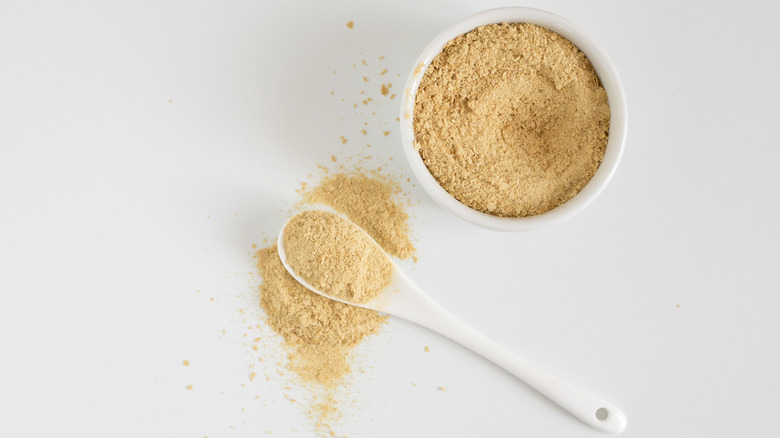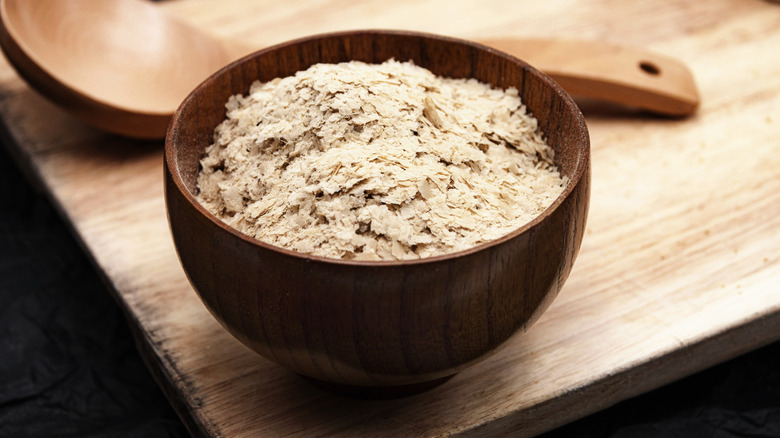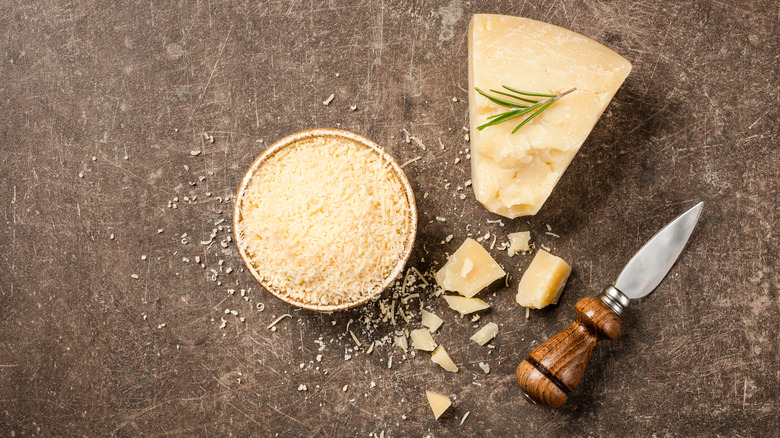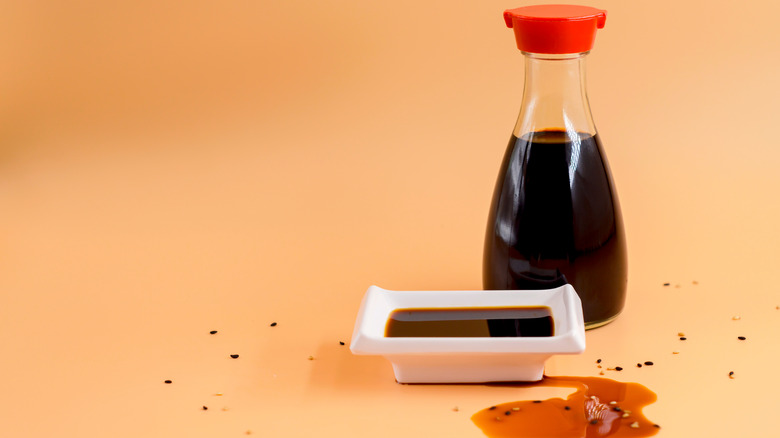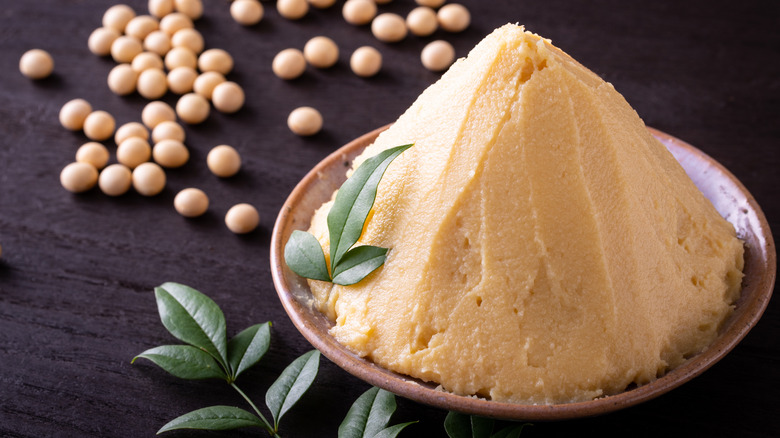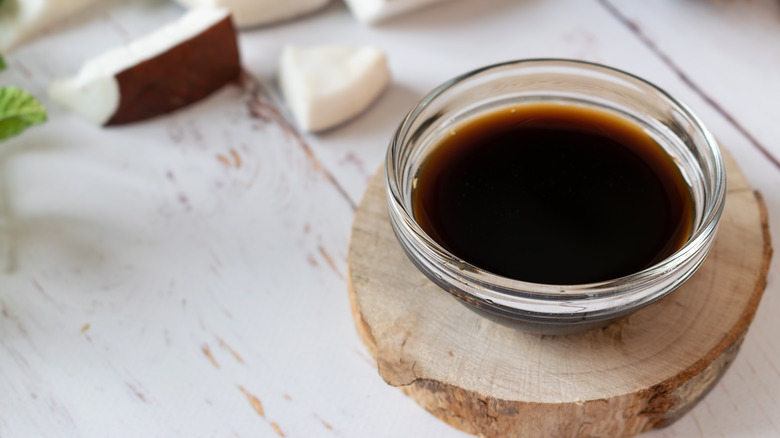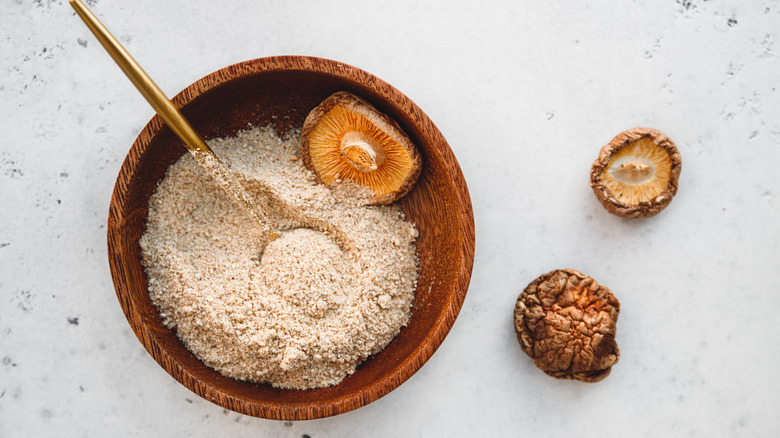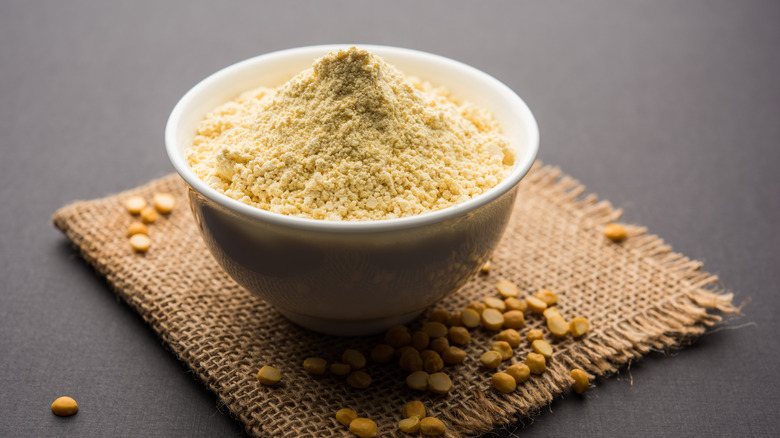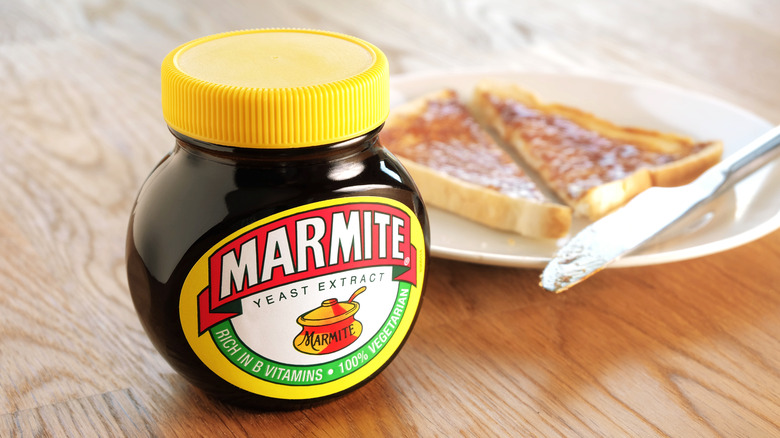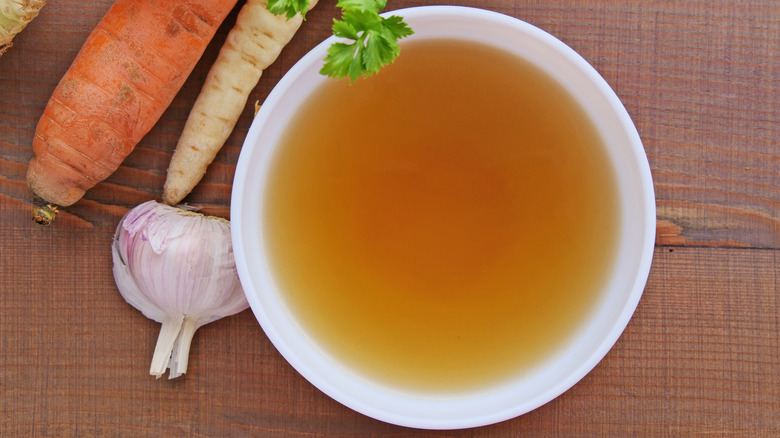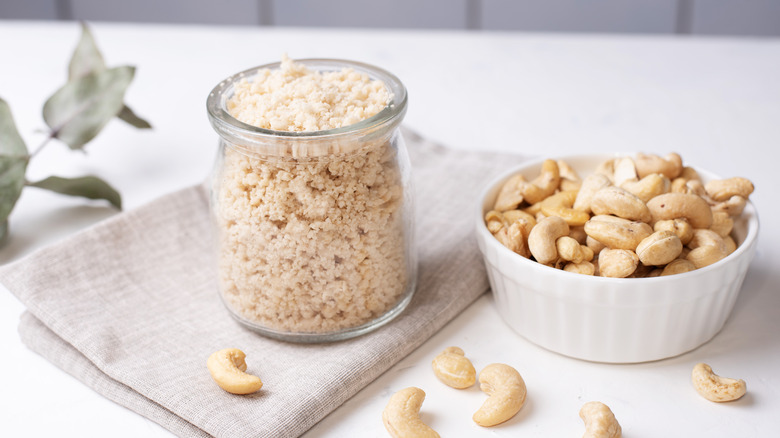10 Best Substitutes For Nutritional Yeast
Whether you're vegan, dairy-free, or simply like to experiment with different foods and flavors, nutritional yeast is something that you've likely tried at some point in your life. Nutritional yeast (or Saccharomyces cerevisiae if you want to get scientific about it) is actually the same type of yeast you'd find in bread and beer — the difference is that the yeast cells are killed in the manufacturing process, rather than while baking, as occurs with bread (via Healthline).
If you've ever gotten a whiff of that yeast-y aroma while making a loaf of bread, you may be wondering how on earth you could incorporate nutritional yeast into a dish as a flavoring agent rather than the thing responsible for the rise in your focaccia. Well, it's actually a flavor-packed powerhouse that you can use in a wide variety of ways, sprinkling it over popcorn for a tasty treat or incorporating it into sauces for a savory twist. The flavor profile has cheesy, nutty notes, so it's a go-to for many dairy-free or vegan diners who miss those cheesy comfort food staples.
There's just one downside — though it's becoming a bit more widely available lately as more individuals branch out with their diets, it isn't always easy to find in every grocery store. So, if there's a recipe that calls for "nooch," as it's sometimes colloquially known, and you just can't get your hands on a package, here are a few substitutes to try.
1. Brewer's Yeast
Brewer's yeast is a byproduct that is created during the beer brewing process, and given that it's core ingredient, Saccharomyces cerevisiae, is the same as nutritional yeast, Healthline notes it's a natural substitution. It has a similar texture as well, as the yeast in this case has been dried into flakes also. The one major factor to take into account is the flavor. Nutritional yeast has been produced in a way that helps to cultivate those cheesy, nutty aromas and flavor notes, but brewer's yeast has, appropriately, a bit more of a beer-centric aftertaste. It can also contain a hint of bitterness that isn't always the most pleasant. However, it reacts in a unique way that can make your recipe a bit thicker, which means it's the perfect substitute if you're using the nutritional yeast to craft a cheese sauce (via I Am Going Vegan).
For best results, swap out one tablespoon of nutritional yeast in your recipe with two teaspoons of Brewer's yeast. The lesser amount isn't because of the consistency or anything like that, since they look very similar, it's simply to ensure that the taste isn't too different, as they do have slightly different flavor profiles.
2. Parmesan Cheese
Since nutritional yeast is often suggested as a substitute for recipes that include parmesan in order to make a dish dairy-free, it only makes sense that the swap would go the other way as well. If you have no issues with consuming dairy, parmesan is an excellent substitute for nutritional yeast because of how similar the taste is. It brings the same type of cheesy, nutty and savory notes to a dish that nutritional yeast does.
The one thing to be mindful of if you're trying to ensure your recipe is as healthy as possible is that parmesan cheese is higher in sodium and cholesterol than nutritional yeast, per Spiceography, and in general has less nutritional benefits. The similarities between the two mean you can swap it in just about any recipe, although the texture and fine ground consistency can be particularly well-suited to sprinkling on popcorn, salads, or vegetables.
For best results, you'll want to swap in the same amount of parmesan as you would have used nutritional yeast — so, if your recipe calls for ¼ cup of nutritional yeast, ¼ of parmesan will do.
3. Soy Sauce
While many focus on the "cheesy" flavor of nutritional yeast, it also has an umami vibe that makes soy sauce a decent substitute (via Organic Facts). Due to the high sodium content, you may want to seek out a soy sauce with reduced sodium in order to avoid overloading your recipe. Soy sauce is very readily available in just about every grocery store, and there's a good chance you may already have a bottle nestled in amongst your condiments in the fridge. One particular thing to note if you're cooking for someone who can't have gluten is that you'll want to make sure the particular soy sauce you choose is gluten free.
For best results, you'll want to reduce the amounts when swapping in soy sauce by about half. For example, if your recipe calls for a tablespoon of nutritional yeast, you'll want to add just half a tablespoon of soy sauce. This reduction is because soy sauce has a stronger flavor. If the ingredient is present in larger amounts, you'll also want to be mindful of consistency, since you're swapping a liquid for a solid. This substitute is particularly well suited for liquid-based recipes, such as soups or sauces.
4. White Miso Paste
Miso is another ingredient that packs that umami flavor punch. While you could technically use any type of miso paste, white miso in particular has a bit more of a nutty flavor, which makes it an ideal swap for nutritional yeast. For those who aren't too familiar with this ingredient, or perhaps have only seen it when prepared in miso soup, it's a paste crafted from fermented soybeans with a thick, somewhat sticky texture and salty, umami flavor. As an added bonus, it's a good source of vitamin E and K, and the fermented preparation means it's packed with good bacteria for your gut health (via BBC Good Food).
Since this is a paste, it works better in recipes where it can be dissolved, such as in sauces or soups. It's not the ideal substitute for recipes where the nutritional yeast is supposed to be sprinkled atop your dish or used as a garnish.
Miso paste is quite salty, so you want to be careful with your substitution. For best results, you should reduce the amount in your recipe drastically, using only about a third as much as the original recipe calls for. So, if your dish requires 1 tablespoon of nutritional yeast, you'll want to use a mere ⅓ tablespoon of miso paste.
5. Coconut Aminos
While this ingredient is a staple in health food stores or in vegan kitchens, it's not the most well-known of substitutes for the average home cook. Coconut aminos are a liquid product that is dark in color and is somewhat like soy sauce, although it has a milder flavor. Coconut aminos have salty, savory, and nutty flavor notes that make it a great substitute for nutritional yeast.
There's a lot to love about this particular substitute. First of all, coconut aminos have far less sodium than soy sauce — 73% less — making them a healthier choice in terms of sodium content (via EatingWell). They also contain no yeast, soy, or gluten, which makes them ideal for anyone struggling with those particular food sensitivities (via Foods Guy). Given their liquid state, this ingredient is an ideal substitute for recipes where the nutritional yeast is incorporated in some type of sauce or broth.
For best results, since coconut aminos are saltier than nutritional yeast and have a hint of sweetness that you won't find in nutritional yeast, you'll want to err on the side of caution and use about half the amount, tasting and making any additional adjustments to your recipe as needed.
6. Dried Mushrooms
If you're looking to swap nutritional yeast with something that has earthy, umami flavor notes, dried mushrooms can be a great, healthy option. Dried mushrooms that have been finely chopped or ground up can be easily incorporated into dishes. The flavors in dried mushrooms skew more towards the savory, earthy notes, and don't really have that same cheesy or salty taste. So, while they can be a great component for some dishes where you want that umami flavor, it's probably not the best swap if you're making something like a cheese sauce where that cheesy flavor is the most important one.
Another thing to consider is the particular type of dried mushrooms you choose to use — some, like porcini, can be a bit more pungent, so you'll have to consider what flavor you're going for (via Foods Guy). Regardless, this can be a great substitute in recipes like soups and stir fries. As an added bonus, they're packed with nutrients including vitamin B, potassium, antioxidants, and even a bit of protein (via Bustle).
If the mushrooms are ground up into a powder, you can essentially use it as a direct swap — so, if your recipe calls for one tablespoon of nutritional yeast, you'd swap in one tablespoon of dried mushrooms.
7. Chickpea Flour With Spices
As with all substitutions, you have to take a moment to consider what that particular ingredient is doing in your recipe in order to determine what an ideal swap might be. Chickpea flour is a great option for dishes where you need to mimic more than just the flavor of the nutritional yeast. In a recipe where you're only swapping out a tablespoon, you can be a bit more flexible with your substitutions, but if you're using ¼ cup or more of nutritional yeast, swapping it out with something dramatically different could totally change your recipe.
Chickpea flour is a great start, as it has a very similar texture and consistency. Then, to get closer to that delicious cheesy, umami flavor, you can add in spices such as paprika and garlic until you're happy with the mixture (via Foods Guy). It can be incorporated in recipes where larger amounts are needed, such as pasta sauces, or even as a topping for adding an extra burst of flavor to dishes.
For best results, you'll want to start with about ⅔ the amount — so if your recipe calls for a cup of nutritional yeast, swap in ⅔ cup of your chickpea flour mixture.
8. Marmite/Vegemite
Yeast extracts, such as the brands Marmite and Vegemite, are popular in certain areas of the world. If you're an adventurous eater (or you live somewhere these spreads are beloved, like Australia or the United Kingdom), you just might have some in your pantry. It has a savory, salty flavor. The fact that it's crafted from yeast means it shares some common flavor notes with nutritional yeast, even containing a hint of that cheesy taste (via I Am Going Vegan).
Since the consistency of yeast extract is like a very thick paste, it's not a good substitute for recipes where the nutritional yeast has to be sprinkled atop your dish, or combined in some type of breading mixture. It's best when used in dishes like sauces and soups.
The spread is quite concentrated, so you don't want to get too heavy-handed with this, as it can quite easily overpower your dish if you add too much. For best results, use about 2 teaspoons of yeast extract for every one tablespoon of nutritional yeast your recipe calls for (via Foods Guy).
9. Vegetable Broth
Given that nutritional yeast is often a component of homemade vegetable bouillon powder, it makes sense that it would serve as a good substitute for nutritional yeast in many recipes (via Intentionally Eat). Vegetable broth is very accessible — you'll find some form of it, whether in cartons as broth or in bouillon cubes or powder, in just about every grocery store. It doesn't contain the cheesy flavors found in nutritional yeast, but it definitely adds a burst of plant-based flavor to whatever recipe you use it in. While nutritional yeast can act as a mild thickener in recipes, vegetable broth will thin out whatever you incorporate it in, so that's something to be mindful of.
For best results, if you're going with liquid vegetable broth, you'll want to use this swap in recipes where the nutritional yeast is found in small amounts so that you're not changing the consistency too much. If you opted for bouillon powder, you can swap it equally — so, for one tablespoon of nutritional yeast, you'd swap in one tablespoon of bouillon powder.
10. Ground Cashews With Spices
Raw cashews are a staple in vegan cuisine, as when they are blended, they can create a sauce with a deliciously creamy consistency. While they don't have the flavor of nutritional yeast on their own, a few seasonings and you can transform this simple ingredient into a great substitute for nutritional yeast. Simply grind raw cashews until they have a fine, powdered texture, similar to the flaky texture of nutritional yeast. Then, add in spices such as dried oregano, garlic powder, sea salt and red pepper flakes.
Minimalist Baker uses the simple ingredients to craft a cashew parmesan cheese that's sure to satisfy your cravings, and it's perfect for anyone who is avoiding nutritional yeast because yeast doesn't agree with them. This powder could easily be incorporated into mixtures for things like cheesy pasta sauce, but the dry, powdered consistency also makes it an ideal substitute for recipes where the nutritional yeast has to be sprinkled on the recipe. Keep a batch in your pantry for dusting on your favorite spaghetti bolognese or lasagna!
For best results, use the same amount of the cashew mixture as you would nutritional yeast.
